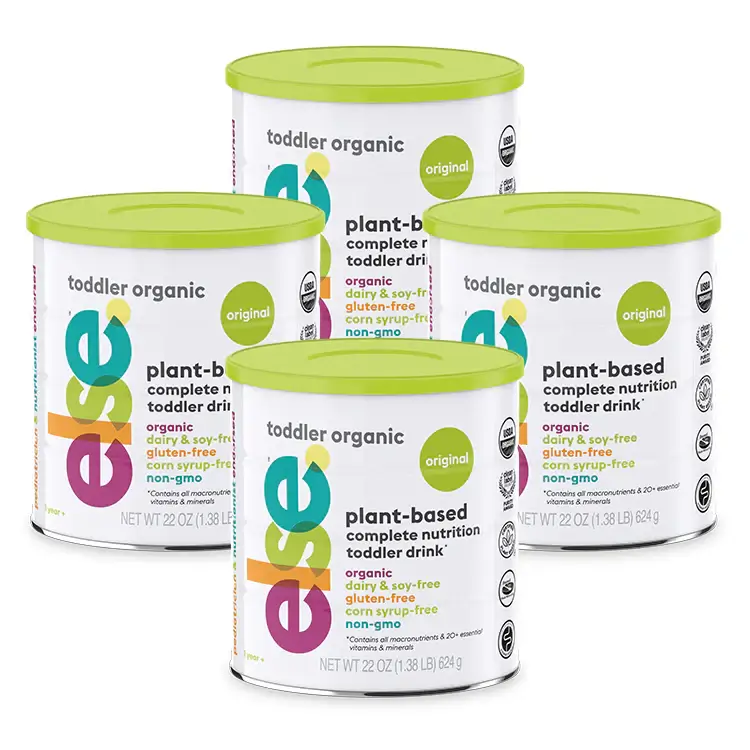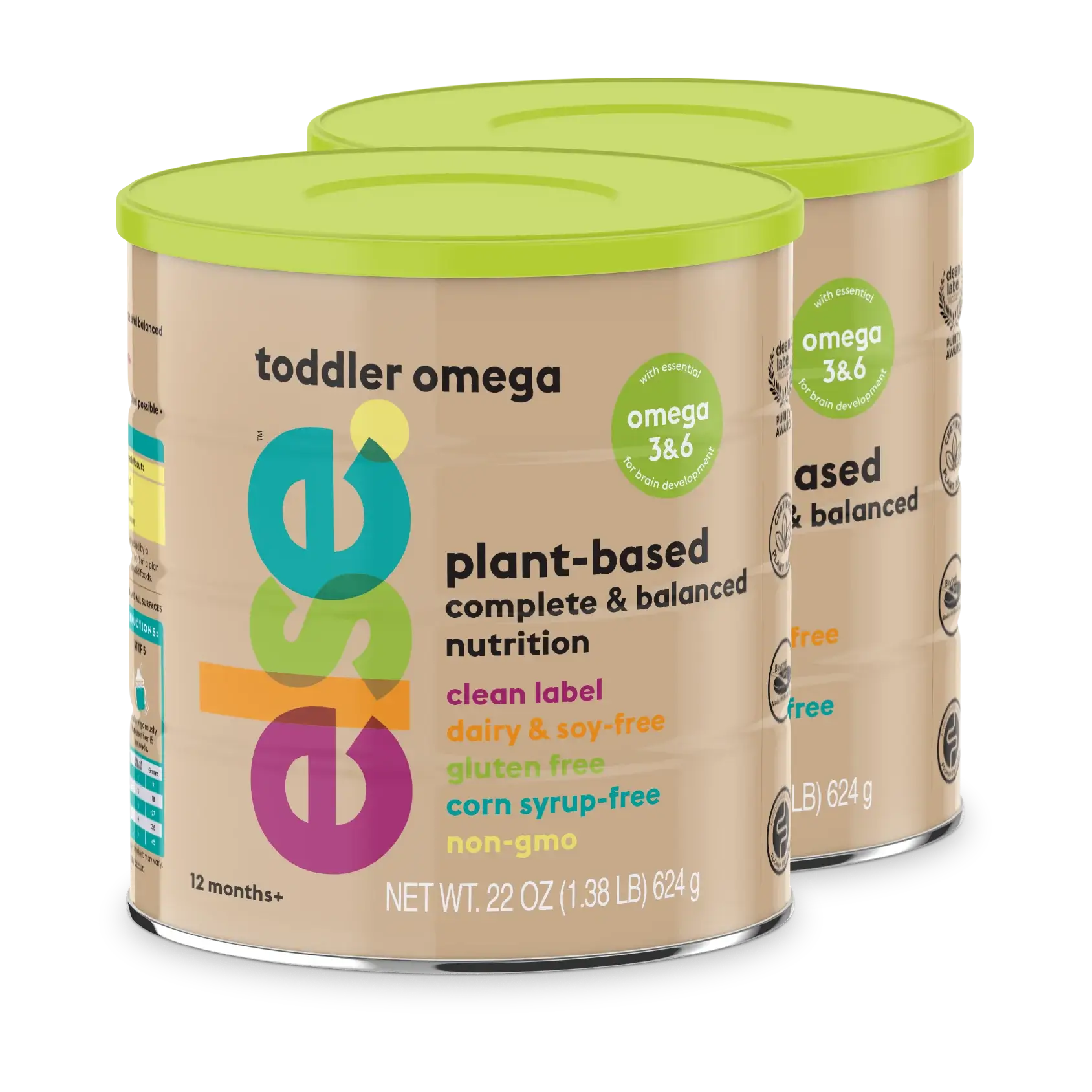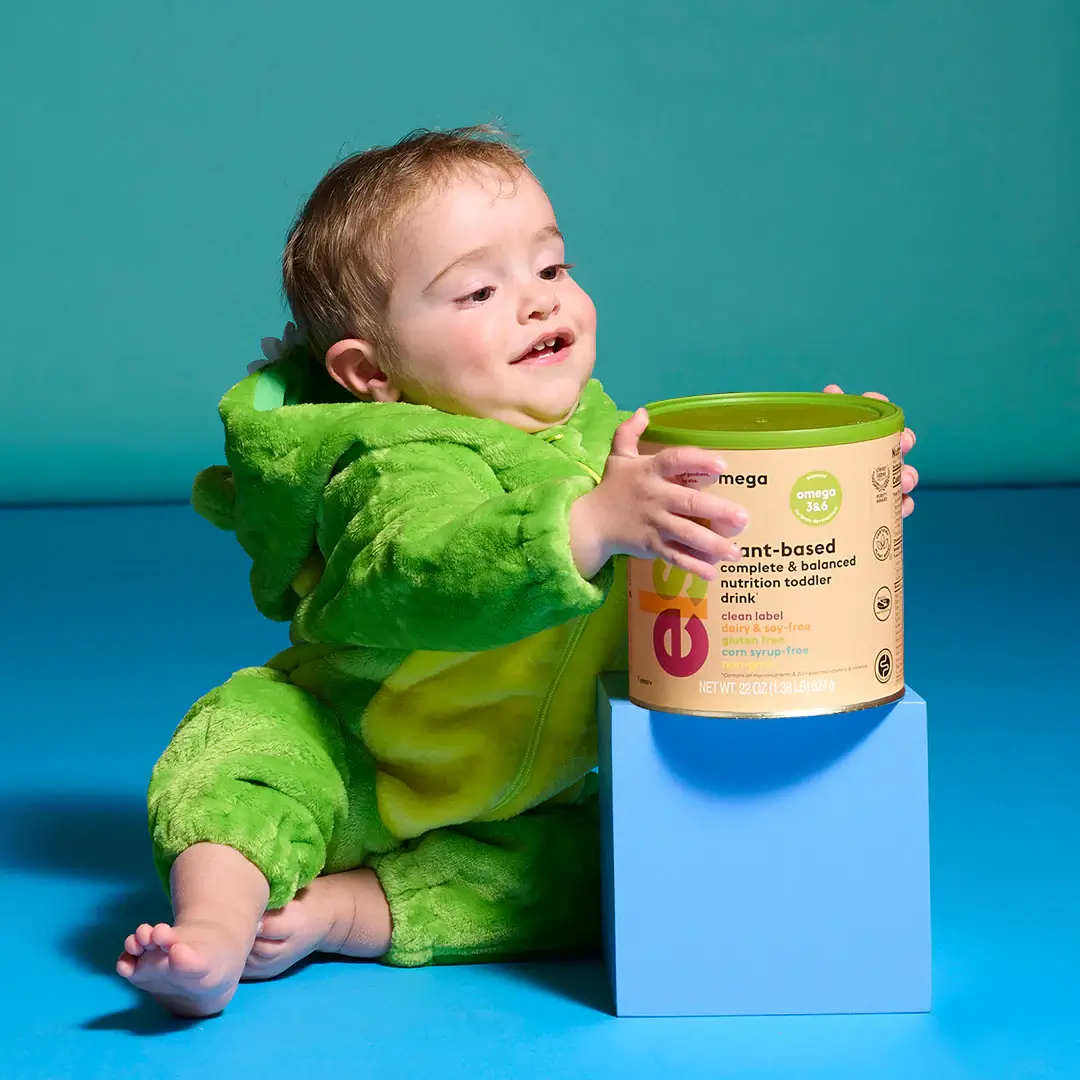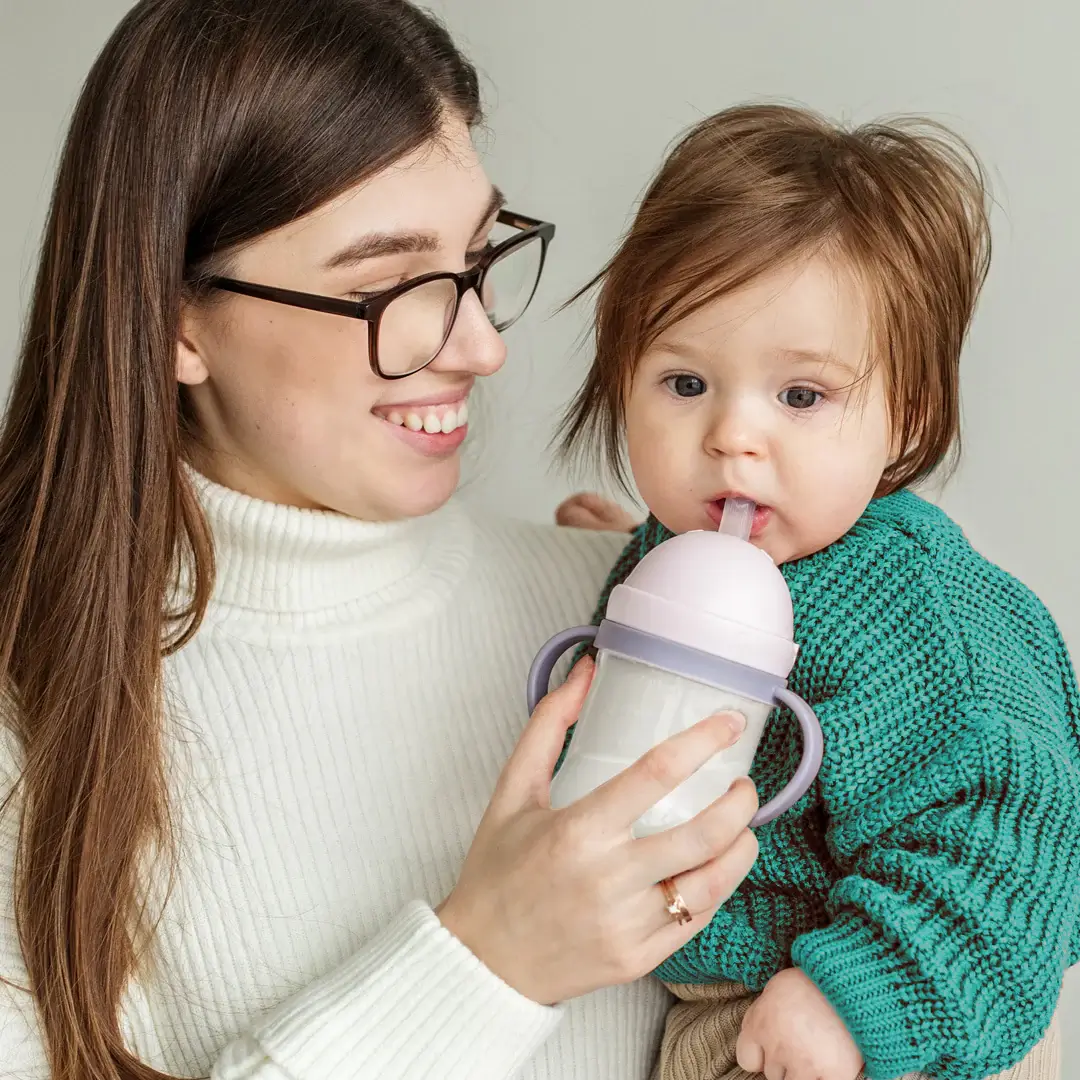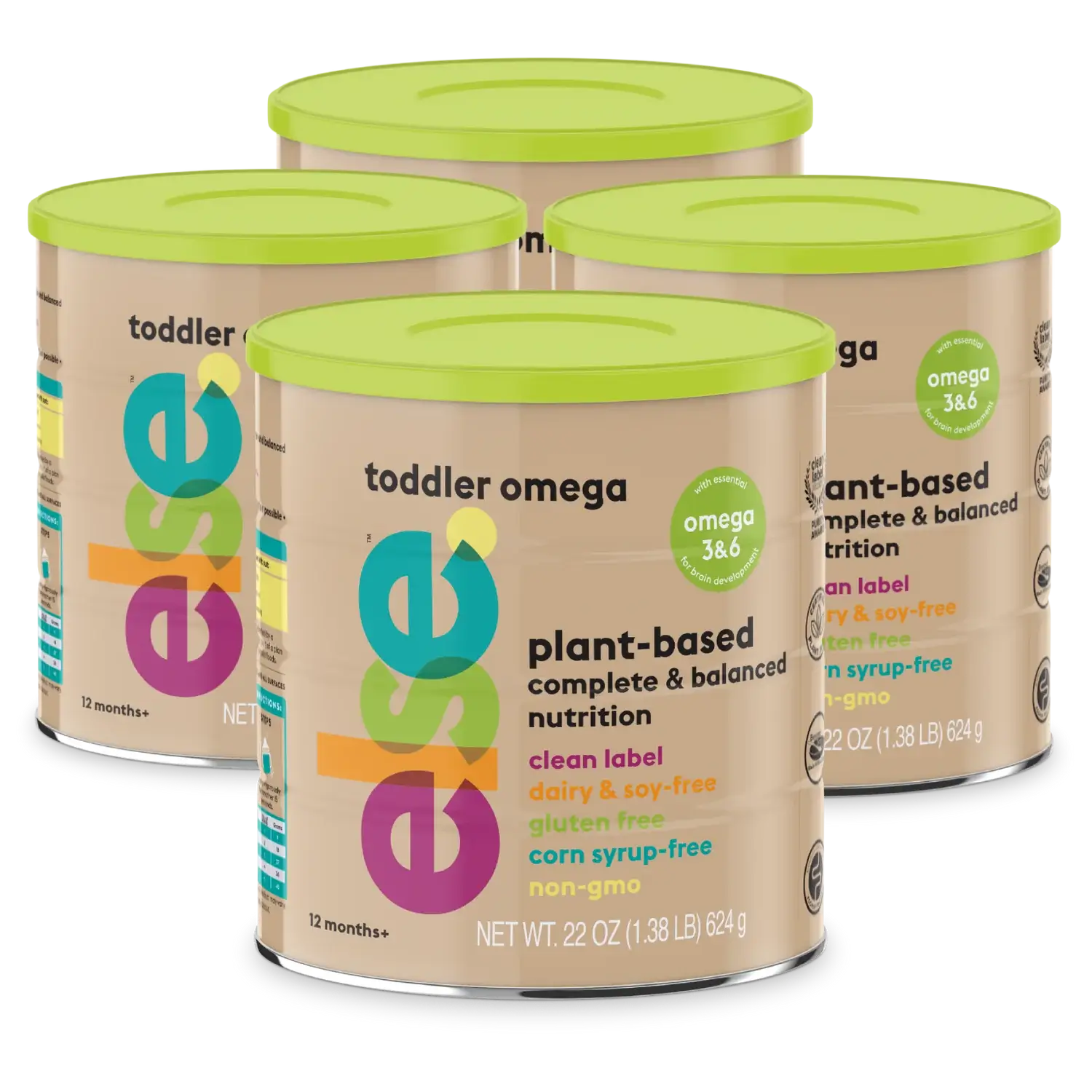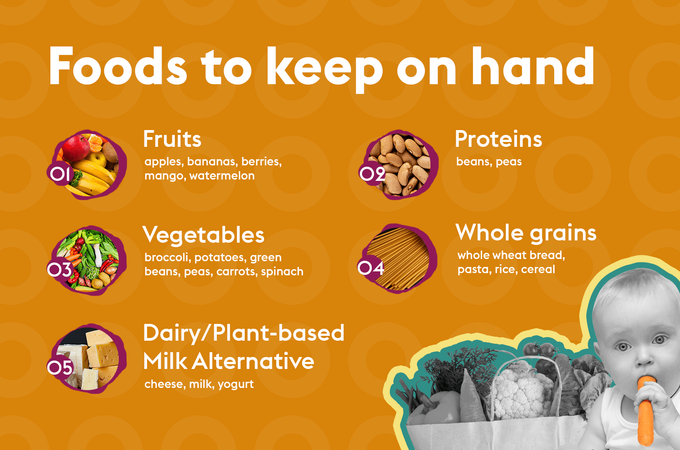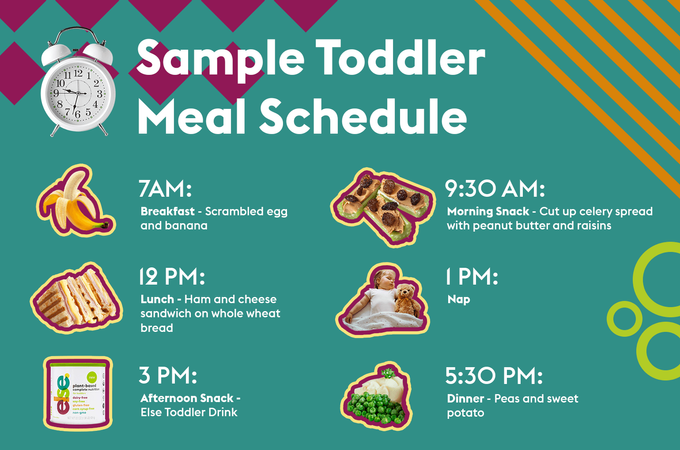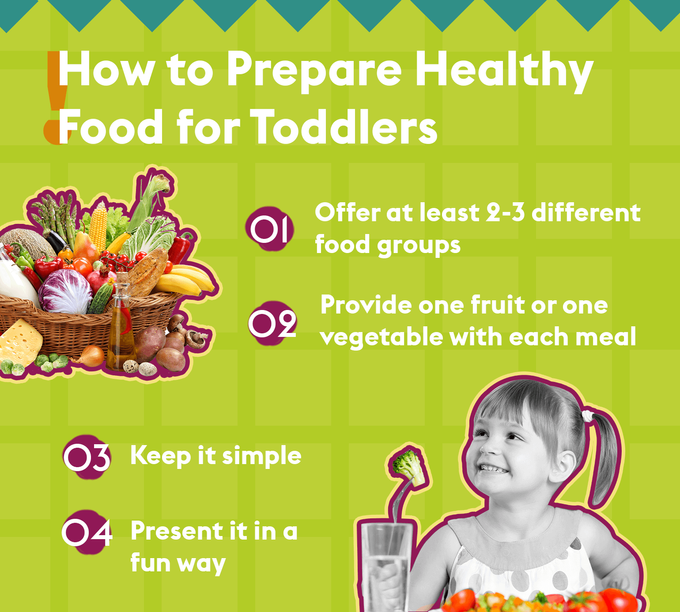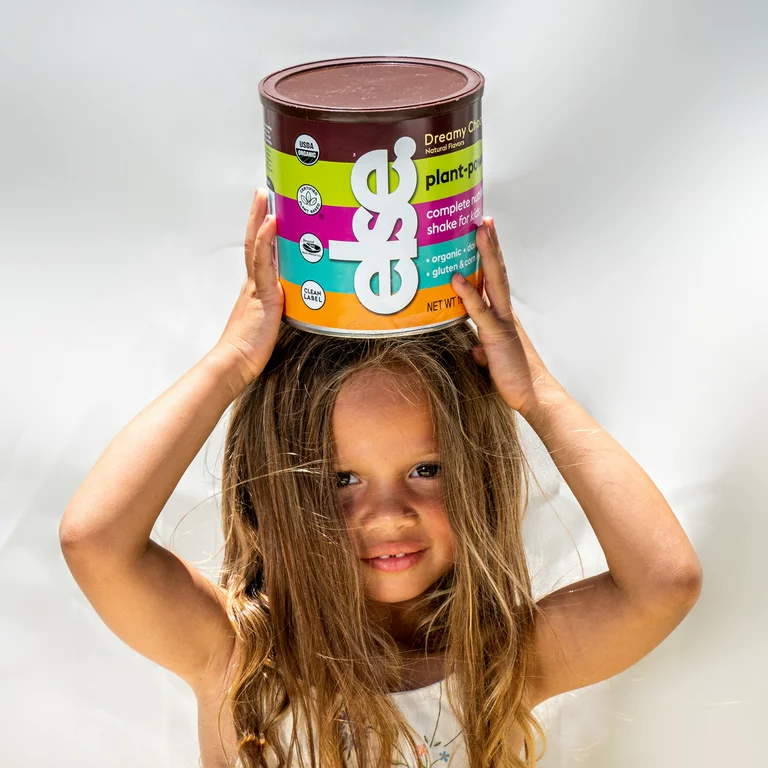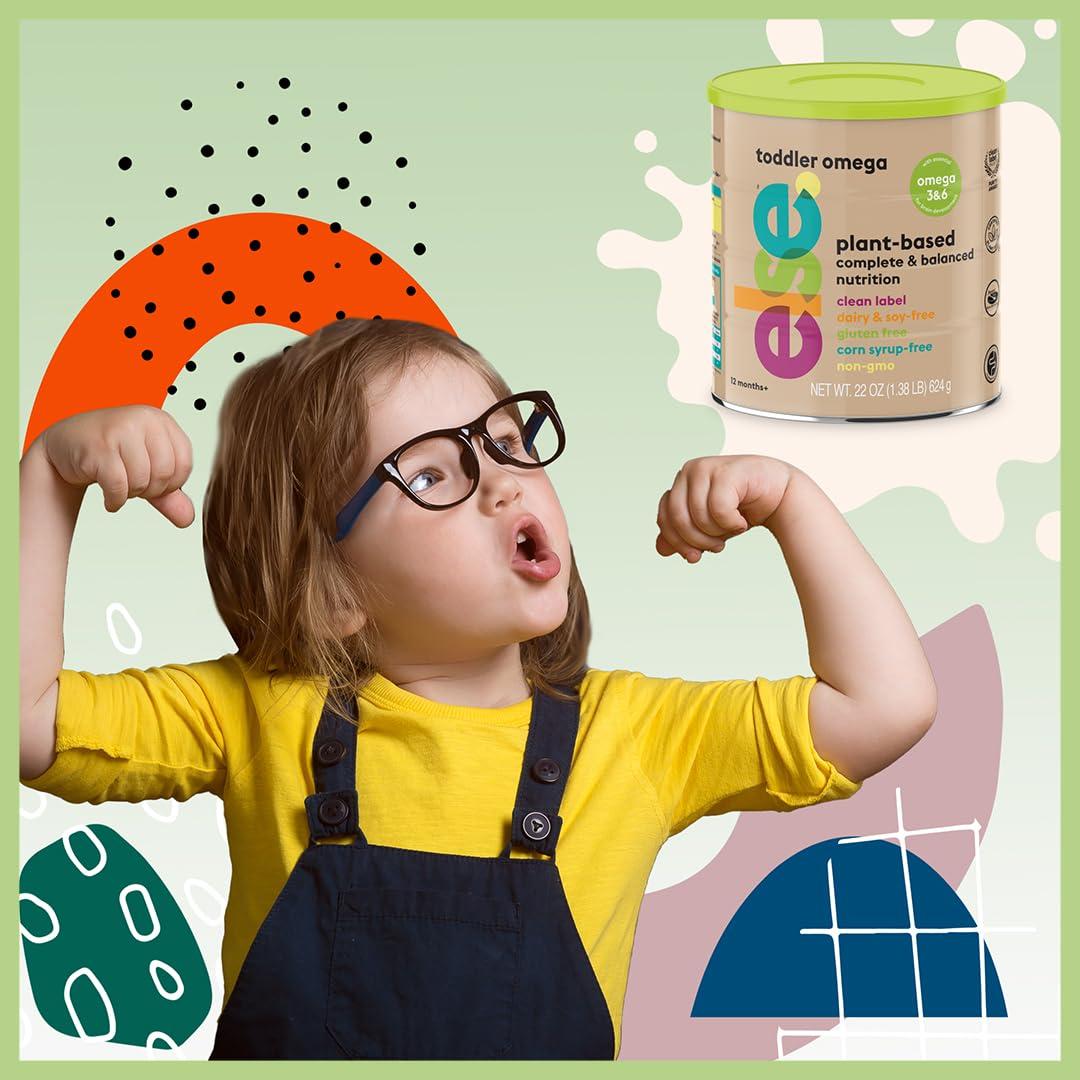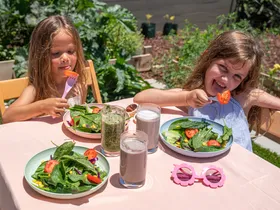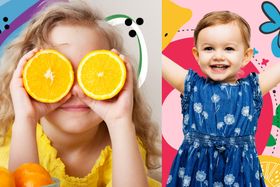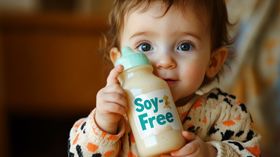Healthy Toddler Food 101: A Guide to Essential Nutrients, Meal Planning, and Healthy Eating
Explore our comprehensive guide to healthy foods and nutrition for toddlers to discover the key nutrients, meal-planning tips, and strategies to support your toddler's healthy growth and development.
Published July 3, 2024.
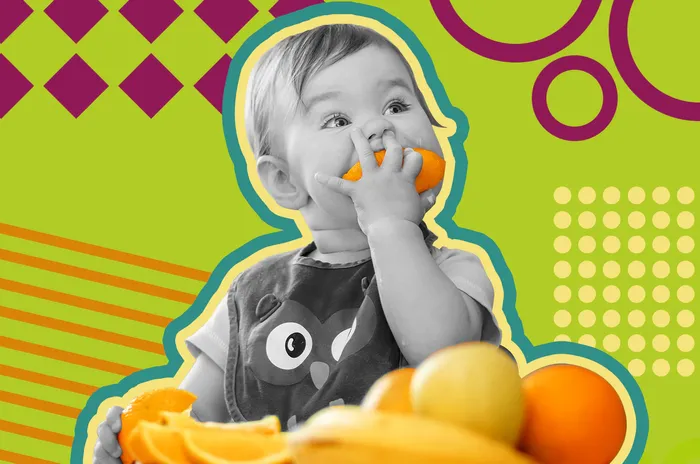
The toddler years, defined as the age of 1-3, are crucial for growth and development in a child’s life. Proper nutrition and a balanced diet are key to supporting this growth and setting the stage for optimal health later in life.
However, toddlers' boundless curiosity and activity levels require offering nutritious, enticing foods to cultivate healthy eating habits. Here's how to choose the right, nutritious foods and present them in an appealing way to encourage healthy eating behavior.
» Explore healthy, delicious, plant-powered nutrition for growing toddlers
Healthy Toddler Food: 7 Key Nutrients
Some of the best healthy foods for toddlers are ones that provide them with the crucial nutrients they need for proper growth. It is important to offer a variety of foods from each food group. Toddlers need a balanced diet with plenty of choices to meet their nutritional needs. Offering a variety of foods also encourages your toddler to experiment and increases their exposure to a wide array of health-promoting nutrients.
» Here's how to create a balanced diet for your little ones
While variety is key, a few nutrients and foods are particularly important during the toddler years. The healthiest foods for toddlers provide adequate amounts of these key nutrients.
1. Iron
Iron is an essential nutrient for toddlers and one that many are not getting enough of. One of iron’s primary roles in the body is to make hemoglobin, a protein in red blood cells that helps deliver oxygen. If your child’s diet is lacking iron, they are at risk for anemia. This can cause weakness, social withdrawal, and learning and behavioral issues.
Some of the best iron-rich foods include spinach, beans, and fortified foods and drinks. To boost iron absorption, it is recommended to consume vitamin C-containing foods with iron.
The daily iron requirement for toddlers is 7-10 milligrams, which is approximately 1 cup of raw spinach or fortified cereal.
» Discover more about iron in baby cereal
2. Vitamin D
Vitamin D is another necessary nutrient in your toddler’s diet. It plays a vital role in building strong bones and teeth and works closely with calcium to do this. It also may play a role in our immune system. Many of us are able to make vitamin D from sun exposure, but not always in adequate amounts.
Mushrooms and spinach are natural sources of vitamin D. Fortified foods and beverages, such as fortified milk, yogurt, and orange juice, also contain vitamin D.
Toddlers need 600 IU (International Units) per day of vitamin D daily. This equals around 3 cups of milk, orange juice, or 3-4 ounces of salmon.
» Learn more about nutrient deficiencies in children
3. Calcium
Calcium is another essential nutrient for your child, promoting the development of healthy and strong bones, teeth, and muscles. Dairy products such as milk, yogurt, and cheese are rich in calcium. Other foods include green leafy vegetables such as broccoli and legumes like beans, lentils, and peas.
Toddlers require 700 milligrams of calcium per day, which equals 2-3 servings of high-calcium foods. One serving is approximately 1 cup of dairy milk, soy milk/yogurt, or 1.5 ounces of cheese.
4. Vitamin E
Vitamin E is an important vitamin that acts as a powerful antioxidant. It helps to protect cells against damage caused by free radicals, which are damaging particles your toddler may be exposed to in their environment. Excessive exposure to these free radicals may lead to an increased risk of cancer, heart disease, and cataracts later in life.
Vitamin E-rich foods include sunflower seeds, almonds, and leafy greens, as well as fortified cereals.
The vitamin E requirement for toddlers is 6 milligrams per day, which can be met with one serving of vitamin E-rich food or drinks.
» Find out all about almonds and why they are so healthy
5. Zinc
Zinc is an essential mineral for proper growth and development. It is involved in the immune system and in managing important mental tasks such as memory, attention span, and learning. Additionally, studies have shown increasing zinc intake may help toddlers reach a healthy height and weight.
Red meat, nuts, shellfish, potatoes with skin, beans, and mushrooms, as well as fortified cereals, are good food sources of zinc.
The recommendation for toddlers is 3 milligrams per day. This can typically be met if your child is eating a variety of zinc-rich foods.
» Discover how to support your kid's natural immunity with nutrition
6. Potassium
Potassium is an important mineral that plays a role in regulating our nervous system and blood pressure and in protecting our bones. A diet with plenty of potassium-rich foods such as salmon, tomatoes, and spinach will help your toddler meet their needs.
The recommendation for potassium for toddlers is 2000 milligrams per day, which is approximately 4 servings of high-potassium foods.
7. Omega-3 Fats (DHA, EPA, ALA)
Omega-3 fats are anti-inflammatory and have numerous health benefits. There are three types of omega-3 fats:
- Docosahexaenoic acid (DHA)
- Eicosapentaenoic acid (EPA)
- Alpha-linolenic acid (ALA)
These essential fats help feed your toddler’s brain and keep it healthy. They may help better manage psychological and behavioral conditions, such as attention problems or depression.
» Find out more about the benefits of both omega-3 and 6 fatty acids
Seaweed, nori, spirulina, and chlorella are different forms of algae that many people eat for their health benefits. Seaweed and algae are important sources of omega-3 for people on a vegetarian or vegan diet, as they are one of the few plant groups that contain DHA and EPA.
» Understand the difference between Omega 3, 6, and 9
ALA is found in plant-based foods such as flaxseed, chia seeds, and walnuts. The daily recommendation for toddlers is 0.7 grams.
How to Choose Healthy Food for Toddlers
As a parent, you play an important role in your toddler’s food choices. But that can sometimes feel overwhelming. A big part of choosing healthy food for toddlers is simply knowing what to look for.
It's a good idea to understand what to look for on the nutrition label of toddler formula and other baby food essentials and familiarize yourself with proper food safety and choking hazards to identify what foods to keep on hand.
» Fuel your toddler's growth with healthy, organic, plant-based nutrition
What to Look for on the Nutrition Label
- Added sugar: Many products, especially those designed for toddlers, can be filled with extra sugar that is not naturally present in that food. This is called “added sugar” and is listed on the food label. Toddlers should have less than 25 grams of added sugar per day.
- Sodium: Excess sodium or salt intake can have negative effects on our health. The amount of sodium is always listed on the nutrition label in milligrams per serving. The recommendation for toddlers is 800 milligrams per day or less. Offering your child more whole foods rather than processed convenience foods will naturally lead to less sodium intake.
- High-fructose corn syrup (HFCS): This genetically modified sugar has found its way into many toddler products. The debate is still out on its potential effects on our health, but it is a big source of added sugar. If you see HFCS as one of the first ingredients on the ingredient list, steer clear of that product. You will not find any HFCS in any of our Else toddler drinks.
» Explore our guide on what to look for and avoid in formula ingredients
Proper Food Safety and Choking Hazards
Young children have immature immune systems. When feeding your toddler, avoid the following to prevent foodborne infection:
- All unpasteurized foods and beverages, including raw milk and unpasteurized juice and ciders
- Raw or partially cooked eggs or foods containing raw eggs
- Undercooked or raw fish or shellfish
- Raw sprouts
- Honey until after their first birthday
Additionally, some foods pose a choking threat to toddlers and should not be given before the age of 4:
- Tough meats like steak
- Grapes, cherries
- Tomatoes
- Hot dogs
- Nuts and seeds
- Popcorn
- Gum and hard candy
» Discover healthy foods for happy and healthy tots
Foods to Keep on Hand
Most toddlers do not eat enough variety, and so keeping nutritious items on hand is important. Repeated exposure to healthy foods will increase the likelihood they will try them and develop a preference for them:
- Fruits: apples, bananas, berries, mango, watermelon
- Vegetables: broccoli, potatoes, green beans, peas, carrots, spinach
- Whole grains: whole wheat bread, pasta, rice, cereal
- Proteins: beans, peas
- Dairy/Plant-based Milk Alternatives: cheese, milk, yogurt, plant-based milk alternatives
9 Best Healthy Foods for Toddlers for Brain Development
There are certain nutrients of critical importance for your toddler’s brain development. These include the omega-3 fats - DHA, ALA, and EPA, as well as other nutrients such as protein, zinc, and iron. Here are the top 9 foods for toddler’s brain health:
- Salmon: Fatty fish such as salmon are rich in omega-3 fats for your toddler’s brain health.
- Eggs: Eggs are packed with choline, a nutrient vital for memory development.
- Peanut Butter: Peanuts are a great source of vitamin E, a potent antioxidant that helps the body use glucose (carbohydrates) for energy.
- Whole grains: Whole grains such as whole wheat bread, brown rice, and cereals contain B vitamins, which nourish a healthy brain and provide energy.
- Oats: Oats provide vital energy needed for the brain, especially for learning and focus. They are also loaded with fiber to keep your toddler’s brain and belly feeling full.
- Berries: Berries such as strawberries, blueberries, and raspberries are packed with antioxidants and may be involved in memory.
- Beans: Beans are brain food for your toddler. They contain a perfect blend of protein and complex carbs to keep your child’s focus and energy steady all day.
- Colorful veggies: Vegetables with a rich, deep color, such as tomatoes, sweet potatoes, carrots, and spinach, are the best sources for brain health.
- Dairy and dairy alternatives: Dairy and dairy alternatives are packed with protein and essential B vitamins, which are essential for the proper growth of brain tissue.
» Find out more about the key role of nutrition in toddler growth
How Much Toddlers Should Eat
Toddlers require about 1,000-1,400 calories per day, depending on age, activity level, and several other factors. Understanding the amount of food each food group requires is helpful.
| Grains | 6 servings/day | 1/4 - 1/2 slice of bread 2-3 crackers 1/4- 1/3 cup cooked rice, pasta, or cereal 1/4 - 1/2 bun, muffin, or bagel |
| Fruits & Vegetables | 5 servings/day | 1/4 - 1/3 cup cooked, canned, or chopped raw 1/4 - 1/2 small fruit/vegetable 1/4 - 1/3 cup juice* |
| Dairy/Milk Alternative | 3 servings/day | 1/2 cup milk or yogurt 1/2 - 1 ounce of cheese |
| Protein Group | 2 servings/day | 2-4 tbsp dry beans and peas 1/2 - 1 egg |
| Fat Group | 3-4 servings/day | 1 tsp margarine, butter, oils |
*Limit fruit juice intake to no more than 4 ounces per day
Aim to provide your toddler with a variety of these foods throughout the day to meet their nutritional needs. In addition to healthy foods, Else offers plant-based nutritious toddler drinks that can help your toddler meet their needs.
Sample Toddler Meal Schedule
Because a toddler’s appetite can vary so much, it is helpful to offer meals and snacks frequently. Think of each meal as being a “mini” meal of nutritious foods and beverages. This way, if your child skips or meal or eats very little, they will have another opportunity to eat shortly after. It is recommended to feed your child every 2.5-3 hours.
Here is a sample 1-year-old feeding schedule:
- 7 am: Breakfast > Scrambled egg and banana
- 9:30 am: Morning Snack > Cut up celery spread with peanut butter and raisins
- 12 pm: Lunch > Ham and cheese sandwich on whole wheat bread
- (1 pm nap)
- 3 pm: Afternoon Snack > Else Toddler Drink
- 5:30 pm: Dinner > Protein source with peas and sweet potato
» Explore nutritious toddler meal ideas, perfect for little picky eaters
How to Prepare Healthy Food for Toddlers
Encouraging your child to eat better can sometimes feel like a challenge. However, there are a few simple steps to follow to create balanced, delicious meals for your toddler:
- Offer at least two to three different food groups: A combination of protein, complex carbohydrates, and fruits and vegetables will ensure a balanced meal. Your child may not try everything, and that’s okay. Offering a variety will encourage them to try at least one food.
- Provide one fruit or one vegetable with each meal: Most toddlers don’t eat enough fruits and vegetables, so offering at least one with every meal will increase their likelihood of trying them.
- Keep it simple: Toddlers like simple meals and don’t need a lot of ingredients. Use sectioned plates to separate the protein, starch, and fruit/vegetable so they can pick and choose what they want.
- Present it in a fun way: Cutting vegetables or chicken into animal shapes can make the meal experience more fun for your toddler! Don’t be afraid to experiment and see what works. You may find that your child loves veggies cut a certain way but won’t touch them if presented in a different way.
Introducing New Foods to Your Toddler
While introducing new foods to your toddler might appear intimidating, it can turn into an enjoyable and rewarding process with a touch of persistence. Research shows that toddlers may require 8-15 exposures to a new food before developing a taste for it.
- To make this process more enjoyable, engage your toddler in sensory experiences. Using flavors and sensory words to describe food increases their curiosity and willingness to try new dishes.
- Another strategy is to expose your toddler to new tastes and textures gradually. Offer new foods in small portions, make slight changes to familiar foods, and involve your toddler in grocery shopping and meal prep.
Remember, it’s all about making trying new foods an enjoyable experience!
» Uncover all about food groups for kids
Healthy Foods for Picky Toddlers
Toddlers often stick to what they’re comfortable and familiar with and are reluctant to try new foods—they don’t like change and want a sense of control and independence. Sometimes, they’re distracted and just want to play. Yet, strategies exist to motivate your toddler to sample new healthy food for toddlers, foster their self-reliance, and aid them in developing lifelong nutritious eating patterns.
How you introduce new foods and create a positive eating atmosphere can significantly influence your toddler's dietary choices.
- Offer one food at a time: If you try to offer several new foods all at once, you’ll probably find your toddler pushing back because they feel overwhelmed. Instead, offer just one new food per meal alongside a familiar food. In this way, they already know there is something on their plate that they enjoy.
- Food chaining: This involves offering new foods similar to your child’s preferred foods and blending flavors and textures they already like.
- Get your child involved in the process: When your toddler sees what you’re making and is part of the process, they feel special. They will then be more likely to try it because they helped create the finished product.
- Be patient: Know that it may take multiple exposures for your child to try and eventually like a new food. Don’t get discouraged or give up. Keep presenting those same foods in different ways. Eventually, your child will give them more of a chance.
- Supplement when needed: If you are trying everything under the sun but are still not gaining traction, Else is here to help. Our organic, plant-based drink is an ideal addition to ensure your toddler's diet includes all the necessary healthy food for toddlers, even when they're selective.
» Discover why plant-based toddler nutrition is so healthy
Healthy Food for Toddlers: Tips & Recipes
Mealtime does not have to be stressful. Creating a relaxed environment and letting your child take the lead can improve nutritional intake and less mealtime meltdowns.
- There are no good or bad foods: Labeling the food on a child’s plate as “good” or “bad” can lead to confusion and result in an unhealthy relationship with food. Research shows that offering a treat during meals results in better intake than only offering it after the meal.
- Don’t force or sneak food: Let your child take the lead on what they want to eat on their plate. Young children crave independence, and so they will want to try food when they are ready to. Additionally, try not to “sneak” healthy food into your child’s meals. They should see, taste, and familiarize themselves with these foods to develop a long-term preference.
- Let your child decide how much to eat: As parents, we want what is best for our children. With this in mind, it is easy to pressure our children to eat when they’re full unintentionally. Your child does not have to finish all the food on their plate or drink all the liquid in the cup or bottle. Present the food in front of them and then let them decide how much they want to have.
- Sit down as a family whenever possible: When you eat together as a family, you teach your toddlers how to eat and help them develop social skills. They also can see that you are eating the food on your plate, making it feel less intimidating for them. It is a fact that children who eat with their parents are more likely to have a balanced diet.
Applying these strategies can make mealtimes more peaceful and enjoyable for parents and their toddlers and, ultimately, improve toddlers' nutrition.
Healthy Recipes for Toddlers 🍓 🍌 🥑 🍉
🍳 10 Healthy Breakfast Ideas
1. Fruit and yogurt parfait Layer fruit on top of your toddler’s favorite yogurt. Top with their favorite low-sugar cereal or granola.
2. PB & J Waffles This is a fun twist on a traditional peanut butter and jelly sandwich. Spread peanut butter and low-sugar jelly on a whole-grain waffle, and watch them enjoy it!
3. Overnight Oats Overnight oats are so quick and easy and can be made ahead of time. For the liquid you can always use Else Plant-based Complete Nutrition for Toddlers, instead of milk. Add a nutritional boost with plant-based yogurt or your toddler’s favorite fruit. 4. Pancakes and fruit Make whole wheat pancakes with a side of fruit. Strawberries, blueberries, or bananas are delicious alongside pancakes. 5. Apple slices with almond butter and string cheese Cut up apple slices and serve with 1 tablespoon of almond butter and string cheese on the side. 6. Egg Muffins Whisk together 8 eggs, 1/2 cup milk, and your toddler’s favorite cut-up veggies, such as broccoli, bell peppers, or tomatoes. Pour into muffin wells and bake at 375°F (191°C) for 15 to 20 minutes.
7. Smoothie Smoothies are a great way to offer more fruit and veggies than your child may normally eat at one meal. Add 1 cup milk, ½ cup fruit, ¼ cup veggies, and 1 tablespoon peanut butter or hemp seeds or a scoop of Else plant-based complete nutrition for toddlers for a protein boost.
8. Breakfast Quesadilla Warm cheese, snipped spinach, and beans in a tortilla. You can also add scrambled eggs. Warm the quesadilla in a skillet just until the cheese melts.
9. Snack Plate Toddlers love snacks, so creating a snack plate is fun for them. Some foods to include are low-sugar dry cereal and protein such as cheese, nut butter, egg, and fruit.
10. Low-sugar cereal Whole grain cereals can be a great way to help your toddler meet their vitamin needs. You’ll want to look for options with little added sugar, a few grams of fiber, and protein for a balanced source of energy. Plus, it’s an incredibly quick and easy breakfast.
🍝 10 Healthy Lunch Ideas
1. Veggie pizza Add sauce, cheese, and your child’s favorite veggies to an English muffin or mini-naan bread. Bake at 400 degrees for about 10 minutes, until the sauce and cheese are bubbly.
2. Pasta with marinara sauce and white beans Add marinara sauce to your child’s favorite pasta. Add on a scoop of white beans for a protein boost.
3. Simple cheese quesadillas Add shredded cheese to a whole wheat quesadilla. Add on diced grapes and steamed or roasted carrots on the side and salsa for dipping.
4. Hard-boiled egg plate Serve eggs with crackers, berries, snap peas, and yogurt-covered raisins.
5. Warmed leftover rice Serve with mashed avocado, chicken, or fish on the side.
6. Chickpea salad wraps Mash up chickpeas, mayo, and fresh dill and spread on a whole wheat wrap. Its texture is similar to tuna, without the strong flavor. This lunch is rich in fiber, protein, folate, and iron.
7. PB&J or sunflower butter and jelly with fruit Add peanut or sunflower butter to a whole wheat pita with jelly. Serve with fruit.
8. Cottage cheese plate Serve with peaches canned in water, raspberries, or pineapples with a side of crackers.
9. Waffle sandwich Top waffle with mashed roasted sweet potato and fruit.
10. Yogurt and fruit Top yogurt with fruit and a whole grain cereal for crunch.
🌮 10 Healthy Dinner Ideas
1. Black bean quesadilla Add beans and a sprinkle of shredded cheese to a whole-grain quesadilla.
2. Whole-grain French toast sticks Make whole wheat french toast with cinnamon and cut into sticks. Serve with light syrup and strawberries.
3. Corn and Bean tacos Add thawed frozen corn and warm for 15-30 seconds in the microwave. Serve in a whole wheat tortilla with salsa on the side for dipping. Add in cooked beans.
4. Quick Pizzas Cut whole-wheat pita into wedges and top with pizza sauce and cheese. Heat in the oven at 325℉ or in a pan on the stovetop just until the cheese is melted.
5. Super simple fried rice Scramble an egg, stir in 1/4 cup peas, 1/4 cup rice, and a drizzle of reduced-sodium soy sauce, and add fruit on the side, like cut-up apples or melon.
6. Apple pancakes Add 1/2 cup grated apple to your favorite pancake batter. Add in 1 teaspoon of cinnamon and cook as directed. Serve smeared with nut butter or a little honey.
7. Cheesy veggie toast Top toast with shredded cheese, thawed frozen peas, broccoli or cauliflower florets, and microwave for 10 seconds to melt. Alternatively, you can serve the vegetables alongside the cheesy toast.
8. Toddler cheese plate Serve with cheese, crackers, fruit, and fresh veggies.
9. Avocado toast and scrambled eggs Spread mashed avocado on whole wheat toast and serve with scrambled eggs.
10. Snack plate Create a fun snack plate with hummus, fruit, veggies, and cheese.
🥨 10 Healthy Snack Ideas
1. Cucumber sticks with hummus
2. Pretzels with a cheese stick
3. Greek plant-based yogurt with chia seeds
4. Boiled egg with strawberries
5. Banana with peanut butter
6. Homemade granola bar
7. Applesauce
8. Cottage cheese with peaches
9. Bran muffins
10. Smoothie made with Else Plant-based Complete Nutrition for toddlers.
🥤 10 Healthy Smoothie Ideas
Fruit Smoothie Ideas
1. Sunshine Orange Smoothie
Ingredients:
- 2 oranges, peeled
- 1 banana, peeled
- ¼-½ cup almond milk
- 1 teaspoon vanilla extract
- 1 scoop Else Plant-based Complete Nutrition for Toddlers
- ½ cup ice
2. Purple People Eater Smoothie
Ingredients:
- 1 banana
- handful fresh spinach
- 1 ⅓ cup frozen blueberries
- 1 Medjool date
- around 1 ½ cups mixed Else Plant-based Complete Nutrition for Toddlers
3. Mango Peach Smoothie
Ingredients:
- around 1 ½ cups mixed Else Plant-based Complete Nutrition for Toddlers
- 1 cup diced peaches, fresh or frozen
- 1 cup chopped mango, fresh or frozen
- ½ teaspoon vanilla extract
- 1 cup ice
4. Coconut Pie Smoothie
Ingredients:
- 3 bananas
- ¼ cup almond butter
- 14-ounce can of coconut milk
- ½ cup coconut flakes
- 1 teaspoon vanilla extract
- ½ cup ice
5. Banana Berry Smoothie
Ingredients:
- 1 medium banana
- ⅔ cup frozen mixed berries
- 2 teaspoons chia seeds
- ⅓ cup Greek yogurt
- 1 ½ cup mixed Else Plant-based Complete Nutrition for Toddlers
- 1 teaspoon honey
6. Frozen Superhero Smoothie
Green ingredients:
- 1 frozen banana
- 2 handfuls of baby spinach
- ½ cup mixed Else Plant-based Complete Nutrition for Toddlers
- 1 teaspoon honey
Pink ingredients:
- 1 frozen banana
- 8 frozen strawberries
- ½ cup mixed Else Plant-based Complete Nutrition for Toddlers
Blend together until smooth. Serve the pink smoothie on top of the green.
Veggies and Fruit Smoothie Ideas
7. Pineapple Green Smoothie
Ingredients:
- 1 cup almond milk
- 1 cup frozen pineapple chunks
- 2 handfuls fresh spinach
- 1 scoop Else Plant-based Complete Nutrition for Toddlers
8. Green Pear Smoothie
Ingredients:
- 1 ripe banana, sliced
- 2-4 slices fresh peeled ginger
- 1 pear, seeded and diced
- 1 ½ cups kale, rinsed and stemmed
- ⅔ cup Else Plant-based Complete Nutrition for Toddlers
- 1 tablespoon honey
- ½ teaspoon vanilla extract
- ½ tablespoon ground cinnamon
- 1 cup ice
9. Purple People Eater Smoothie
Ingredients:
- 1 banana
- 1 handful fresh spinach
- 1 ⅓ cup frozen blueberries
- 1 Medjool date
- 1 ½ cups mixed Else Plant-based Complete Nutrition for Toddlers
Oats Smoothie Ideas
10. Chocolate Peanut Butter Banana Smoothie
Ingredients:
- 1 banana, frozen
- 1 cup mixed Else Plant-based Complete Nutrition for Toddlers
- ¼ cup old-fashioned rolled oats
- 3 tablespoons natural peanut butter
- 1 tablespoon cocoa powder
- Chocolate chips for serving (optional)
Blend together until smooth.
» Explore more wholesome and delicious meals for toddlers
Nurturing Toddlers' Healthy Growth
The toddler years are a critical period for growth and development, and it's essential to instill lifelong habits of choosing healthy food for toddlers during this formative stage. If you're worried about your child's nutrition, Else offers a supportive option. Our delicious, complete nutrition toddler drinks are a 100% organic, plant-based solution that can fill the nutrient gaps in your child’s diet.
The content and advice provided in this article are for informational purposes only and are not a substitute for medical diagnosis, treatment, or advice for specific medical conditions. Always consult a pediatrician to understand the individual needs of your child. The article expresses the views of the brand editor.
FAQs
What should I feed my 1-year-old for food?
For a well-rounded diet, offer your 1-year-old an array of healthy food for toddlers from the family's dining options. This should feature a blend of vegetables, fruits, dairy or dairy alternatives, grains, protein sources like meats or legumes, and wholesome fats.
Aim to serve 1 tablespoon of vegetables for each year of age, half a piece of fresh fruit, half a cup of milk or a plant-based drink suitable for toddlers, and a small serving of proteins, be it animal-based or plant-based, like legumes or nuts.
Such meals will supply the crucial nutrients for robust growth and development.
What are good finger foods for a 1-year-old?
Ripe bananas, peach, watermelon (remove the seeds), raspberries, blueberries, and cantaloupe cut into small pieces are all great finger food options for a 1-year-old! Enjoy watching them discover new flavors and textures. Happy feeding!
What is the best food routine for a 1-year-old?
For a one-year-old, a daily regimen of healthy food for toddlers usually consists of three main meals and two to three snacks, spaced every two to three hours to complement their daily schedule. At this stage, solid foods become the primary source of energy and nutrition, crucial for their development.
What are some essential nutrients for toddlers?
Toddlers need to eat from all food groups, which will provide protein, healthy fats, vitamin D, calcium, fiber, iron, and other nutrients to support their overall growth and health. These nutrients are essential for their development.





